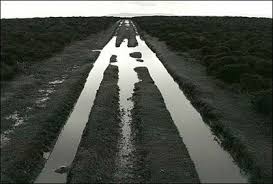
I was a junior in college at the time. I was studying to be a history teacher. I was miserable. Everyday I would drive to classes, take notes on the French Revolution or “The Best Practices for Teachers” and go back to my apartment and study. It seemed like I was doing the same thing every day and every day I was doing the same thing.
I was in a rut.
You know, that place that feels comfortable, yet doesn’t challenge you.
If you travel to Eastern Oregon and visit The Oregon Trail Interpretive Center you can stand on a hill and look out over the prairie and still see the ruts that the wagons left behind over a hundred years ago. But before that trail was so well worn, it was blazed by expeditious folks who took great risks to seek a better life.
However with each passing party, the trail became easier for those pioneers to pass through. Then eventually, with everyone following it, the road became full of ruts, often causing the wagon wheels to get stuck, especially when the rains came.
That’s where I was at age 20…stuck. I couldn’t get out of my own wet, muddy rut. It was the first time I would say I was depressed.
For some reason though, I was able to see that I was in a rut and I needed a change. I decided right in the middle of my junior year to take some time off and work with an organization that sponsored programs for inner-city kids living in public housing neighborhoods in Philadelphia.
That decision changed the course of my life, got me out of my rut and it’s the reason I’m where I am today.
As a development professional I believe it’s easy to find yourself in a rut. The path has been cleared by those who have gone before you. It’s easy and comfortable to follow that path, but it’s also fraught with danger and complacency. Here’s a list of possible “ruts” that you can get stuck in.
- Do you find yourself on the phone with your donors rather than out in their homes or places of work?
- Is 75% of your communication through e-mail?
- Are most of your donor visits over lunch?
- Do you find yourself in your office or cubicle for most of the day?
- Do most of your “asks” involve mostly unrestricted gifts?
- When you wake up most mornings, do you dread going into work?
If you find yourself in this kind of rut, the first thing to do is acknowledge it and come up with a plan to get out of it and blaze a new trail. Here are some ideas:
- If you’re having trouble reaching a donor by e-mail or phone, plan an “unplanned” visit to your donor’s home or workplace.
- Go through your caseload and write down all the interests and hobbies your donors have and find pertinent articles to send them. You’ll be amazed at the response.
- Look at restaurant reviews in your local area and arrange a meeting with your “foodie” donors at a new place.
- Instead of seeking all unrestricted gifts, start finding creative projects for specific donors who have a passion for them and ask big!
- Spend an entire week outside your office. Get out to meet your donors everywhere.
- Create a weekend retreat for 6-8 donors on your caseload. Come together to solve and fund a problem that your organization needs help with.
- Review your caseload and cull donors who shouldn’t be on it. Find some new blood from donors who have capacity and propensity, but have not been asked.
- If you find your organization is just complacent and unwilling to change, start looking for a place that values ingenuity and risk taking.
Look, it’s easy to follow the same old path. And in some ways, the old path can be very valuable and there is much to be learned from it. But, if you allow it to, it can make you lazy, tired and bored…and eventually unproductive. You don’t want to be in that place.
Get out of your rut. Blaze a new trail. Yes, there is uncertainty and risk involved, but isn’t that the way you want to live your life?
Jeff







0 Comments